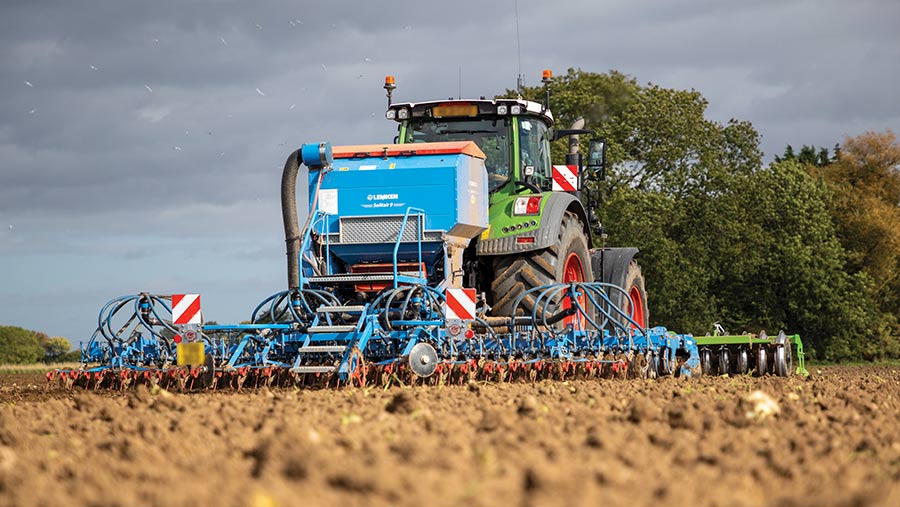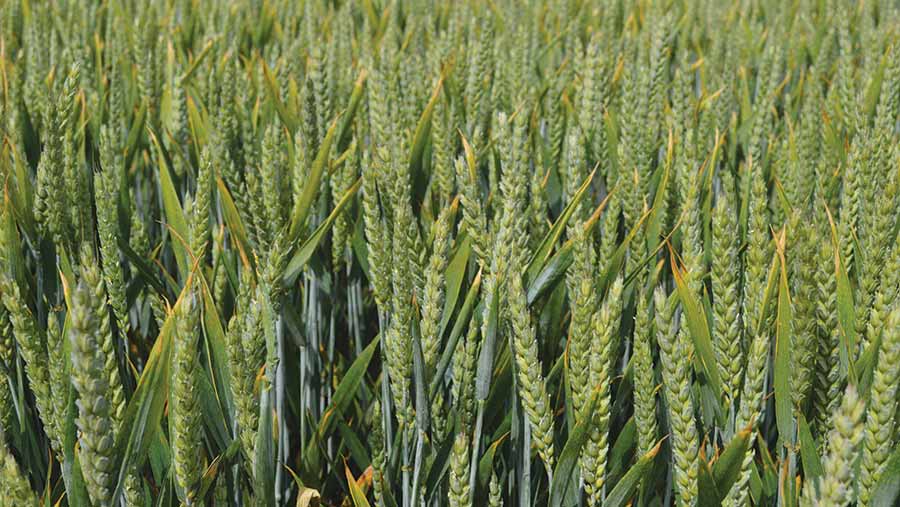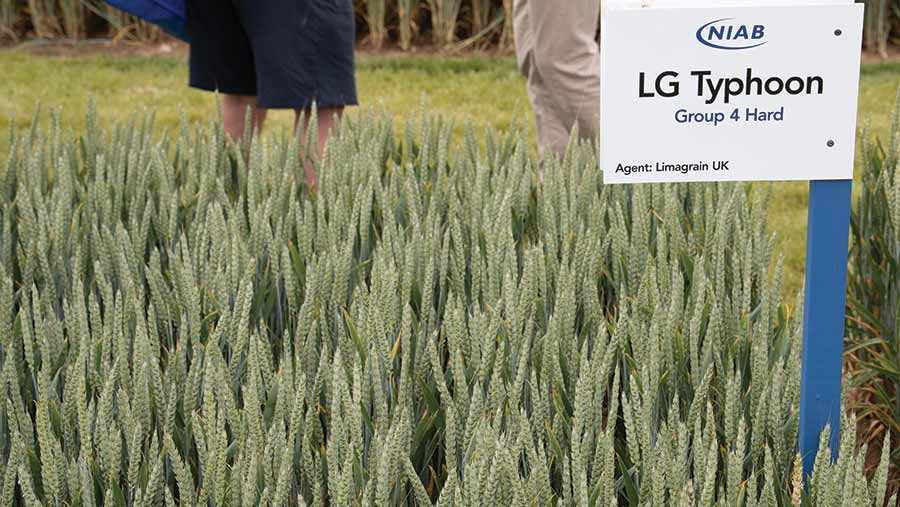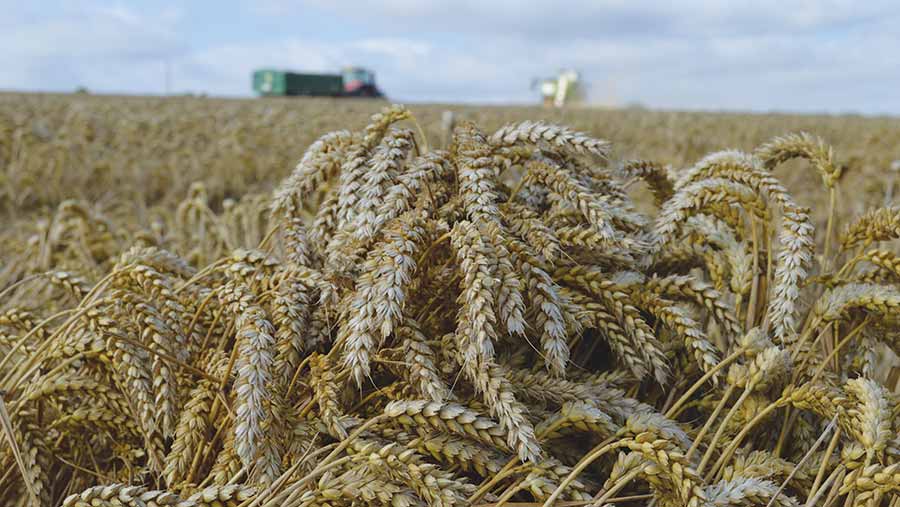Wheat variety choices to help reduce risk this autumn
 © GNP
© GNP Five expert agronomists across the UK have recommended low-risk, consistent performers, alongside eye-catching newcomers, when choosing winter wheat varieties for harvest 2024.
Fertiliser prices have crashed to the lowest level since 2021, but the wheat price has also dropped and other inputs like plant protection products remain historically high.
With septoria pressure at its worst since 2012, Association of Independent Crop Consultants (AICC) members believe the pressure placed on fungicide chemistry is also a concern.
See also: Variety blends: Do they work in oilseed rape?
Peter Cowlrick
CCC Agronomy/AICC, Hampshire/Sussex
Peter Cowlrick sees two clear trends in winter wheat variety choices over recent seasons.
The first is a move away from quality wheats due to nitrogen costs for harvest 2023.
Many growers who were producing 100% milling wheat are now split 75-25 between Group 1 and Group 4 hard wheats, and there is no guarantee the trend will reverse.
“It’s a reflection of economics and taking risk out of the business. I think growers are less stressed if they don’t have 100% milling wheat.”
Among Group 1 varieties, Peter says Crusoe lost followers due to its brown rust susceptibility, but they’ve now flooded back for its unrivalled nitrogen-protein conversion efficiency.
Although its septoria rating is not as good as it was, it is manageable and has taken area off Zyatt and Skyfall, which both have disease weaknesses.
Key points – South/South East
- Trends Group 1 area moves to less-risky hard Group 4s
- Top picks Crusoe, Gleam, Dawsum, Champion, Typhoon
- One to watch Redwald
“Clients have been looking at Group 1 blends in recent seasons to cancel those out, either 60-40 or 50-50 Crusoe-Zyatt.
There is certainly a reduction in yellow rust pressure when combining the two and, with Crusoe in the blend, protein conversion is increased compared with Zyatt alone.
The blend area could rise, depending on results this harvest, and early indications suggest it’s a manageable and successful approach.”
Peter says a significant move into Group 2 variety Extase, which provides growers with a dual market option of growing for milling or as feed wheat.
“It combines excellent septoria resistance and vigorous growth – earlier development and maturation is a bonus for those growers looking to follow wheat with oilseed rape.”

Dawsum wheat © MAG/David Jones
Feed choices
Gleam has been a go-to feed wheat in his area, valued for its standing power, midge resistance and good specific weight of 77.3kg/hl, but disease resistance is less robust than it was.
Competing with Gleam for area is Dawsum, with its respectable septoria score of 6.4 and high specific weight of 80kg/hl.
For the past two years, it achieved top yields in AICC trials, which test candidates and established varieties in the east and south of England, under both high- and low-input regimes.
“It doesn’t produce huge quantities of straw, so helps manage residue in non-inversion systems. Its only big weakness is no midge resistance.”
Champion is very encouraging with its high septoria score (8.1), he adds, but its straw strength does not lend itself to early drilling and it has a relatively low specific weight.
“Its aggressive growth might suit direct drilling and as it’s suitable for later drilling, it will fit nicely behind Gleam and Dawsum in a drilling programme.”
Typhoon is another interesting Group 4 option, with a septoria score of 7.3, strong tillering and a good specific weight of 77.1kg/hl, so it provides a good overall package.
Peter also highlights high-yielding soft Group 4 Redwald as one to watch, although its 5 for lodging resistance could prevent it getting a foothold in the market. “Prolific tillering is perhaps why it gets leggy, so it could suit lower seed rates on wider rows to help it stand.”
Steve Cook
Hampshire Arable Systems/NIAB/AICC, Hampshire/Wiltshire
Traditionally, the West Country has been a stronghold for milling wheat production because of its typically early harvest and slightly lower yield potential than other regions.
This has seen growers chase a premium, rather than high output, and aim to get grain in the barn in a timely fashion, protecting Hagberg falling number.
However, Steve Cook says the quality focus has slipped over recent seasons since the closure of the Hovis flour mill at Southampton in 2018.
Soft Group 3s for export were popular, and while an outlet is still there – albeit with some Brexit-related difficulties – growers no longer have robust varieties to grow following the Cougar parentage affair.
“We are down to Astronomer and Illuminate now, which aren’t bad varieties, but don’t capture the same imagination in the market. Yields are also lower than Group 4s.”
Key points – West
- Trends Shift from Group 1s/3s to Group 2s/hard 4s
- Top picks Extase, Palladium, Dawsum
- Ones to watch Typhoon, Champion, Bairstow
Move to Group 2s
Growers have moved to Group 2s such as Extase, with a septoria score of 7.8, and Palladium, with a 7.4 score, growing them as feed.
“They have a low response to fungicides, which is key, and there are no great weaknesses. Extase’s earliness allows workloads to be spread alongside later varieties. At T2, for example, it helps the sprayer operator to get everything on in time, which is important in a high-pressure year like this.”
Grain quality to take advantage of any potential export opportunities from south coast ports is key when selecting hard Group 4s.
Graham and Gleam have fitted this bill over recent years.
“They are starting to lag in terms of septoria rating, so a move to Dawsum is happening right now, with its low response to fungicide and big specific weight of 80kg/hl.
“There is quite a bit of Typhoon tried this year, too. It’s further back on yield, but low-risk and looking good in the field. Champion has a low specific weight, so is an out-and-out feed variety, but its septoria rating is a plus against any minuses.”
There is a limited market for soft Group 4s as poultry feed, and Bairstow would be Steve’s pick here, despite the addition of Redwald to the Recommended List with a yield of 107% of controls.

© Tim Scrivener
David Boulton
Indigro/AICC, Central
Historically, the central area has been a Group 3 biscuit wheat stronghold, with growers feeding local outlets like Weetabix at Kettering.
However, diminished Group 3 variety performance has seen a significant drop for harvest 2023.
“I estimate just 5-10% of wheat is for the biscuit market this year here, with Astronomer the most reliable option, as it was least affected by its Cougar parentage.
Other Group 3s have been replaced by Crusoe, with good demand for milling wheat locally through Heygates and Camgrain.”
Group 2 Extase has also gained a following, as it’s suited to low nitrogen regimes and can gain a premium for blending into bread grists.
“It has excellent septoria resistance, but we have seen a bit more yellow rust creep into the variety this year and that should be watched.”
Group 2s to consider for seed multiplication are Ultimatum and Palladium, says David. Both have solid disease resistance and complementary maturity characteristics compared with Extase.
Key points – Central
- Trends Group 3 area plummets, hard Group 4s up
- Top picks Extase, Dawsum, Gleam and Champion
- Ones to watch Zealum, Beowulf
Group 4 demand
Demand for soft Group 4 feed wheats continues to grow, with several poultry units locally.
“A new variety – Zealum – is interesting. It looked good in trials, with good standing ability and suitability for earlier drilling, so complements established Skyscraper.”
Gleam has been David’s go-to Group 4, with flexible sowing, consistent high yields and good performance as a second wheat.
However, yellow rust and septoria must be well managed.
“I’m looking at Dawsum as a replacement this autumn. It is relatively flexible on sowing date, with solid disease resistance and high yield. Champion looks very clean this year and, as a later-sown variety to manage its lodging risk, it would complement Dawsum nicely.”
Of the candidates, Beowulf has caught David’s imagination, with a Gleam cross Costello parentage that should provide high yield, good grain quality and solid disease resistance.

Champion wheat © MAG/David Jones
Marion Self
Prime Agriculture/AICC, Suffolk
Marion Self says 2022-23 will focus minds on risk when picking wheat seed for the drilling campaign.
Disease resistance and straw strength is being severely tested this year, with earlier wet and growy conditions requiring robust fungicide and plant growth regulator input.
“Some are concerned about how much programmes are costing, but this needs to be measured against margin over input cost, which will be rewarded in years like this.
“The skill is using intelligence from Recommended List and AICC trials to put varieties in the right position based on their strengths and weaknesses.”
Key points – East
- Trends Disease resistance brought into sharper focus in 2023
- Top picks Gleam, Dawsum, Typhoon, Champion
- Ones to watch Cranium, Insitor, Grouse, Mayflower
Consistency
Marion says Gleam has been well liked for its consistency and will remain in plans for harvest 2024, but its disease resistance has been tested and may give away some ground to cleaner newcomers.
These include Champion and Typhoon, both with excellent septoria resistance scores, and Dawsum, which has a solid all-round disease resistance profile.
Typhoon is slow to develop, so its traits suit earlier drilling, followed by Dawsum, then Champion with its weaker straw strength.
Marion says Dawsum has carried slightly higher septoria levels than the other two, scoring 6.4 rather than 7+, but this would be expected and shows the accuracy of Recommended List data in assessing disease risk.
Group 2 Extase is also popular, offering good yields, quality and a robust disease package, with the potential to attract a milling premium if managed accordingly.
Later drilling
She says those looking for suitability for late drilling after roots could consider Cranium or Insitor, with both yielding well when sown after 1 November.
Looking ahead, she is enthused by barley yellow dwarf virus resistance traits coming through, which may enable more to sign up for the £45/ha no-insecticide Sustainable Farming Incentive (SFI) option.
Grouse is available in limited quantities and provides a step up from Wolverine, which fell away due to its less-robust disease resistance.
“It’s something to look forward to and should be embraced if the full package is there, alongside its barley yellow dwarf virus resistance.
“Mayflower is another interesting Group 2 quality wheat and is said to be well suited to low-input systems, with good nutrient use efficiency and disease resistance.”
Mike Neaverson
Neaverson Growers/AICC, Lincolnshire
Yellow rust presents a significant challenge across Mike Neaverson’s area in south Lincolnshire, so his clients have moved away from highly susceptible varieties.
Key casualties have been Zyatt and Skyfall, which both score 3, replaced by Group 2s such as Extase for its agronomic strengths, including strong resistance to septoria and rusts.
This makes it his number one choice for clients with a low-input system, and it is also a very good second wheat, with a respectable 102% yield when grown in that position.
“It’s Achilles heel for me showed itself last year when we had a perfect wheat-growing season.
“Yields were exceptional around the Wash, but Extase was generally 1t/ha behind other varieties.
“That says to me that it doesn’t have the genetic potential of others on fertile sites, but I still like it in the right place, with its early vigour and competitive growth habit useful where there is blackgrass.”
Key points – North
- Trends Move away from weak yellow rust scores
- Top picks Extase, Dawsum
- Ones to watch Champion, Typhoon
Group 4 dominates
Elsewhere, hard Group 4s dominate and Mike’s clients have moved away from the established variety Gleam, with a yellow rust score of 5, to more robust options.
Those growers are turning to Champion, Dawsum and Typhoon, which all combine high yellow rust resistance scores with good or very good resistance to septoria.
This is the first year he has walked significant areas of these varieties, and his observations on disease levels and growth habit during 2023 offer some insight into where they might fit in drilling programmes for harvest 2024.
Mike says Dawsum is carrying a little more septoria than its 6.4 rating suggests. Conversely, Champion’s 8.1 septoria rating has translated into lower levels of disease and looks promising for managing risk.
“Typhoon has impressed, too, but its slow development means it should be drilled early. Dawsum would be sensible mid-season to ease septoria pressure, while Champion can drill late to manage its lodging risk,” adds Mike.

